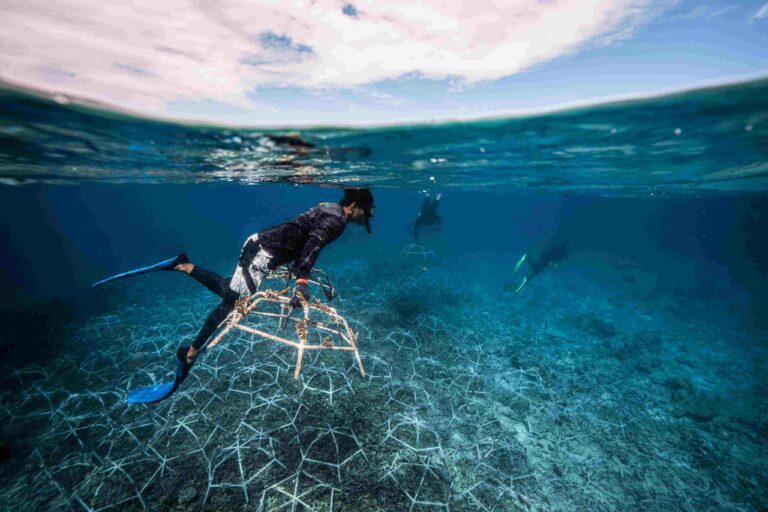Planting new coral on degraded reefs can lead to recovery so rapid that the restored reefs end up growing as fast as healthy reefs after just four years, according to new international research led by the UK’s University of Exeter.
The study was based in Indonesia at a site where blast fishing destroyed large reef areas 30-40 years ago – and it had shown no signs of recovery before the human intervention.
The Mars Coral Reef Restoration Programme is designed to restore degraded reefs by transplanting coral fragments onto a network of interconnected, sand-coated steel frames known as “reef stars”.
The Exeter researchers studied the reefs to assess whether the important ecosystem functions of a healthy reef could be restored, in collaboration with the Research Centre for Oceanography, Indonesia’s National Research & Innovation Agency (BRIN), Mars Sustainable Solutions and Lancaster University.
“The speed of recovery we saw is incredible,” said lead author Dr Ines Lange of Exeter. “While reef restoration cannot solve the problem that reefs are severely threatened by climate change, it shows that active management actions can help to boost the resilience of specific reefs, and bring back important functions that are critical for marine life and local communities.”
Carbonate budgets
The Exeter researchers developed a means of monitoring “reef carbonate budgets” – the net production or erosion of a reef over time – as a way of predicting its ability to grow, keep up with sea-level rise, protect coastlines from storms and provide a habitat for reef animals.
To evaluate if and how fast these reef functions return after coral restoration, the carbonate budgets were measured at Mars reef sites that had been restored for a few months or over one, two or four years, as well as on degraded and healthy control sites.

In the years following coral transplantation the level of cover, colony sizes and carbonate production rates tripled. After only four years, restoration sites were indistinguishable from nearby healthy reefs in every measured respect.
This meant that the restored reefs were not only growing at the same speed as healthy reefs but providing similar habitat for marine life and efficiently protecting the adjacent island from wave energy and erosion.
Transplanted coral fragments are a mixture of different types of branching corals, so the composition on restoration sites is different from that on normal healthy reefs, which also harbour many boulder-like and encrusting corals. This could affect habitat provision for larger marine species and resilience to future heatwaves, because branching corals are more sensitive to bleaching.
“This is a really encouraging discovery,” commented Lancaster University's Dr Tim Lamont, who initiated the collaboration. “If we can maintain climate conditions that allow for coral survival, it’s possible to restore even very damaged reefs back to healthy, functional systems within relatively short periods of time.” The study is published in Current Biology.
Also read: Sheba restores reef with The Film That Grows Coral, What YOU can do to help coral reefs, Mass Coral Breeding, Genetic Goldmine of Tough Corals








